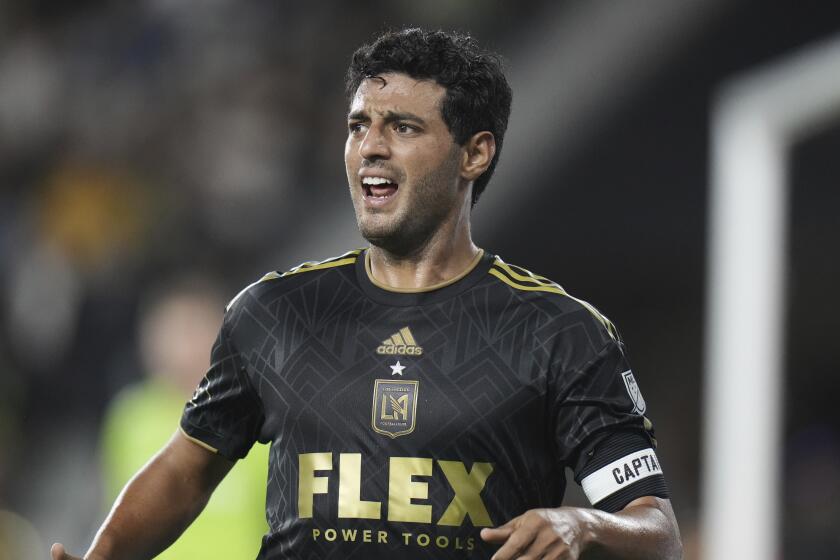Different Styles Bring Super Results
- Share via
SAN DIEGO — As athletes, John Elway of Denver and Brett Favre of Green Bay are similar in size, strength and power. But as quarterbacks, Elway, 37, and Favre, 28, are as dissimilar as they are unusual, playing the same game in dramatically different ways. A comparison:
Power
They’re alike only in physical dimensions and strength.
Elway came into the NFL 15 years ago as the first modern quarterback--at 6 feet 3 and 215 pounds, the big guy with a gun for an arm.
Favre at 6-2 and 225 is the most recent model of that type, the NFL’s preferred type today. A resolute flamethrower, he is, like Elway, big and tough enough to take the big hit and shrug it off.
Character
Elway has always been the exemplar of the mentally tough player. He is fearless against the blitz, toughest in the clutch, and fights hardest when behind in the fourth quarter. In comebacks, Elway is the master.
Joe Montana, another famous comeback passer, was a wholly different sort. He never had to turn it on to win in the last minute because, every game, he was precisely the same man, playing the same great, steady football, first quarter or fourth.
Favre is another kind of fighter. He will take on anyone. As for comebacks, Favre is untested against the NFL’s better teams, for, on a must-win day, the Packers are too good to fall behind in the fourth quarter.
Passing
Elway has learned the classic modern passing motion introduced in the 1960s by Hall of Famer Joe Namath and continued by Troy Aikman, among other great quarterbacks.
As a typical Denver pass play begins, Elway is in the pocket, feet spread, left shoulder pointed slightly forward. Then, rapidly, he uncoils to throw without having to step forward. The velocity on Elway’s passes, short or long, comes from the swift turn of his body as he pulls his left hand back and fires.
Favre has a volleyball motion. Passing the ball, he is like a volleyball player spiking the ball. He doesn’t uncoil. Jackknifing his body, he snaps forward as he lets the ball go. His arm is the NFL’s strongest. He doesn’t need either foot on the ground to throw a football 35 or 40 yards.
With that motion--throwing with his arm rather than his body--Favre is probably heading for arm trouble someday.
Elway, however, can keep throwing forever. The Namath motion takes the load off the arm.
Mobility
Elway was the NFL’s first quarterback to consistently take advantage of the truism that when a defensive team accounts for every runner and receiver, there’s nobody left to challenge a great passer if he pulls the ball down and runs. Today, Elway, slower and running less frequently, compensates with the courage to stand there and throw the ball into the teeth of the blitz.
Favre is a wild scrambler. With uncommon insight, he deduces the speed and direction of blitzers and, frequently escaping just in time, has the skill to deliver the ball left-handed, underhanded, backhanded, or backing up. Elway today is the more disciplined quarterback. Favre makes his undisciplined style work.
Tactics
Although both of these quarterbacks have ridden the West Coast offense to the top, neither is an ideal West Coast quarterback.
Elway came up as a long-striding, over-the-top, downfield thrower. By the time he perfected the Namath motion, he was too old to master the quick rhythm pass--the quick drop and throw--that is at the heart of West Coast football.
Nor, at his age, are his feet quick enough now. Nor does he throw the touch pass well. His preference is to stand back in the shotgun formation--which really is no part of the West Coast way--and power the ball down the field.
Although the shotgun set sometimes costs Denver the threat of Terrell Davis’ running, Denver’s pass plays are all West Coast plays, and these, combined with Elway’s ability to throw straight and hard, have made him the AFC champion again.
Favre has been schooled in the West Coast offense since he was 22. That is his edge on Elway. Five years ago, when Mike Holmgren left San Francisco to coach the Packers, his hardest job was teaching Favre the new offense. They wrangled for a few years.
By last year’s Super Bowl, Favre had learned it well enough to win a ring. And this season, he learned a little more. He also has a great team around him. The Packer combination of tactics and personnel is among the best in NFL history.
More to Read
Go beyond the scoreboard
Get the latest on L.A.'s teams in the daily Sports Report newsletter.
You may occasionally receive promotional content from the Los Angeles Times.










